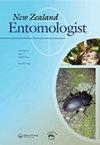Beetle (Coleoptera) communities inside and outside the pest-resistant fencing of a New Zealand ecosanctuary
IF 0.4
4区 农林科学
Q4 ENTOMOLOGY
引用次数: 0
Abstract
ABSTRACT The ecological impacts of invasive mammals are widely documented around the world. In New Zealand, fencing designed to exclude non-native mammals is used for conservation and restoration efforts. The Orokonui Ecosanctuary is a 307-hectare coastal Otago reserve (Dunedin, New Zealand) that is surrounded by mammal-exclusion fencing. The goal of the present study was to investigate how excluding mammals and including (native) animals inside the Orokonui Ecosanctuary fence has influenced ground- and litter-dwelling beetle (Coleoptera) abundance, diversity, and community composition. We hypothesised that beetle abundance, diversity, and community composition would be different whether the beetles sampled were from sites inside the fence or outside the fence. Beetles were extracted from the litter and soil of six sites (three inside, three outside) two times (once in winter, once in summer). The abundance, diversity, species composition, size distribution, and trophic guild distribution of beetles inside and outside the fence and between seasons were compared. Our results suggest that sites inside the fence harbour a greater abundance and diversity of beetles. We found a high abundance of native beetles both inside and outside the Orokonui Ecosanctuary’s fence. Further research may find evidence that the fenced sanctuary is providing a ‘halo effect’ whereby native beetles thriving within the Orokonui Ecosanctuary are spreading out into the surrounding landscape and also outcompeting introduced beetles.新西兰生态保护区内和外的甲虫(鞘翅目)群落
摘要:哺乳动物入侵对生态的影响在世界范围内得到了广泛的研究。在新西兰,为了保护和恢复工作,设计了栅栏来排除非本地哺乳动物。Orokonui生态保护区是一个占地307公顷的奥塔哥海岸保护区(新西兰达尼丁),周围环绕着哺乳动物隔离带。本研究的目的是探讨在Orokonui生态保护区围栏内排除哺乳动物和包括(本地)动物如何影响地面和垃圾栖息的甲虫(鞘翅目)的丰度、多样性和群落组成。我们假设甲虫的丰度、多样性和群落组成在围栏内外都是不同的。从6个地点(3个在室内,3个在室外)的凋落物和土壤中提取甲虫两次(冬季一次,夏季一次)。比较了围栏内外和季节间甲虫的丰度、多样性、种类组成、大小分布和营养行会分布。我们的研究结果表明,围栏内的地点庇护着更丰富和多样化的甲虫。我们在Orokonui生态保护区的围栏内外都发现了大量的本地甲虫。进一步的研究可能会发现证据表明,这个围栏保护区正在提供一种“光环效应”,即在Orokonui生态保护区内茁壮成长的本地甲虫正在向周围的景观扩散,并且也在竞争中击败了引进的甲虫。
本文章由计算机程序翻译,如有差异,请以英文原文为准。
求助全文
约1分钟内获得全文
求助全文
来源期刊

New Zealand Entomologist
ENTOMOLOGY-
CiteScore
0.70
自引率
33.30%
发文量
3
审稿时长
>12 weeks
期刊介绍:
The invertebrate diversity of New Zealand is of great interest worldwide because of its geographic isolation and geological history. The New Zealand Entomologist plays an important role in disseminating information on field-based, experimental, and theoretical research.
The New Zealand Entomologist publishes original research papers, review papers and short communications. We welcome submissions in all aspects of science regarding insects and arthropods in a New Zealand or Australasian setting. The journal’s subject matter encompasses taxonomy, phylogenetics, biogeography, biological control and pest management, conservation, ecology and natural history.
The journal is the official publication of the Entomological Society of New Zealand. Papers published or submitted elsewhere for publication will not be considered, but publication of an abstract or summary elsewhere (e.g. conference proceedings) does not preclude full publication in the New Zealand Entomologist. Accepted papers become copyright of the Entomological Society of New Zealand. The journal is published in English, but we also welcome publication of abstracts in Maori.
 求助内容:
求助内容: 应助结果提醒方式:
应助结果提醒方式:


